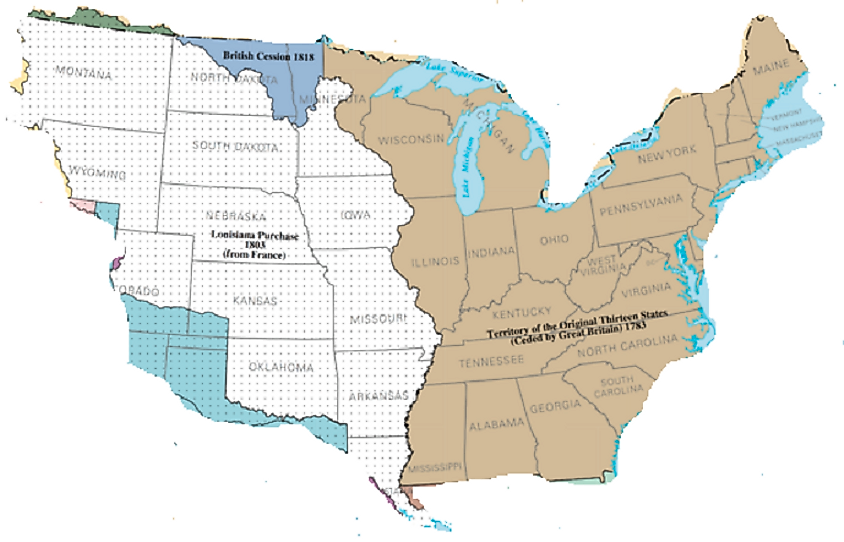What Was The Louisiana Purchase?

6. Background and History of the Deal
The 828,000 square miles involved in the Louisiana Purchases included parts of 15 modern US states and small parts of what is now Canada. The year 1803 was a great year for the young union, as France sold a quantity of land to the United States that literally doubled its size overnight. Thomas Jefferson clinched the deal that consisted of lands raging from the gulf of Mexico to the Canadian border, with additional lands ranging from the Rocky Mountains in the west to the Mississippi River in the east. The lands of this purchase had previously been acquired by France from between the start of the 17th Century and the middle of the 18th Century. French explorers had put up settlements after settlements along the Mississippi River, the Great Lakes, New Orleans, and even Montana beforehand as they went about acquiring these lands for the French crown.
5. Terms of the Purchase
The transfer of ownership of Louisiana Territory to the United States from France was done in much the same manner as part of it was acquired beforehand by France from Spain. All public lands and structures except for private properties were to be transferred to the United States. All people in the said territories would become US citizens, and have the same rights as United States citizens. After the transfer of territory ownership, military troops not belonging to the United States would vacate their military posts, and leave US territories within three months thereafter. Treaties between original owners and any Indian nation would stand until such time that a new treaty became necessary. Furthermore, honoring former treaties, the importation of goods into the United States by Spain or France would be given favor, and the payment of purchase would signify the cancellation of debts of France to American citizens.
4. Areas Involved
The purchase of Louisiana cost the United States around $15,000,000 USD, of which $11,250,000 USD was used as payment for the land, and $3,750,000 USD as cancellation of claims that France owed to certain American citizens. Half of the inhabitants of the purchased land were settlers, and most of the rest were African-American slaves. Minor strips of present-day Alberta and Saskatchewan, now parts of Canada, were also part of the purchase. Parts of 15 present US states were also included in the deal. Namely, it included portions of what are now Louisiana, Colorado, Montana, Wyoming, Kansas, New Mexico, Texas, the Dakotas, Minnesota, Nebraska, Arkansas, Oklahoma, Missouri, and Iowa. Although there was initial opposition to the purchase from the Federalist Party, Thomas Jefferson, President of the United States at the time of the purchase, stated that he had enough constitutional power to enter into such treaties.
3. Habitat and Biodiversity
The habitats of what was once Louisiana Territory feature hardwood forests, pine flats, pine uplands, tidal marshes, prairies, and swamp woodlands. Cypress and tupelo swamps mark the areas as well, while Black Walnut trees, Eastern Red Cedar, and Beech dominate the alluvial basins. Orchids and hyacinths can also be seen among the trees. The woodlands in the region also have turkey, quail, wood ducks, woodcocks, and mottled ducks among their avian fauna. Many fur-bearing animals, very commercially important at the time of the Louisiana Purchase, are also found in the area, including minks, opossums, muskrats, skunks, nutrias, and bobcats. Bears, rabbits, deer, and squirrel also roam the forests, and were important sources of game meat as well as fur. The area's lower waters are famous for their commercially lucrative Red and White crayfish populations, and several-hundred year old live Oak Cypresses abound in the area's forests and cities today, living remnants from the era of the acquisition.
2. Economic Impacts and Territorial Disputes
The Louisiana Purchase enabled urbanization to prosper in what were once wilderness areas and sleepy French and Spanish hamlets. Prospects in commerce, agriculture, trade, mining, and an influx of settlers had a great economic impact to the areas included in the Louisiana Purchase. These factors in turn enabled great growth and prosperity to ring in the age of the new, independent union of states in North America. In the beginning, many early Americans and government officials were skeptical about the newly acquired vast territories being brought in by the Louisiana Purchase, especially in terms of protecting such a large area from future invasions. However, the pioneering spirit and exploration that early Americans were imbued with persisted, as they went about settling new farmlands and embarking upon adventurous endeavors in these new territories. Land disputes between settlers and the Native Americans, however, largely remain unsettled, as the government appropriated land reservations with the settlers' interests in mind more than those of the native inhabitants.
1. Legacy and Modern Significance
The legacy of the deal remains important today. Even after the Louisiana Purchase Bicentennial was celebrated, increased interest and awareness of how the deal was made has made it all the more important to modern Americans. The historic and cultural aspects of the deal have made preserving the ecological wealth that the purchase had endowed the country with all the more important as well. This has done a great deal in regards to highlighting the importance of environmental preservation and the ecological benefits that it has brought to the United States. Today, one of the conservation and preservation efforts' results have come with the successful maintenance of the centuries' old live Oak Cypresses that are still seen dotting the landscape in Louisiana from Cat Island to Goat Island. Other old growth habitats all throughout the area have also been preserved. Recognition by the US Forest Service of these forests has been made an important component of the national agenda in the effective management of American biodiversity and natural resources.











